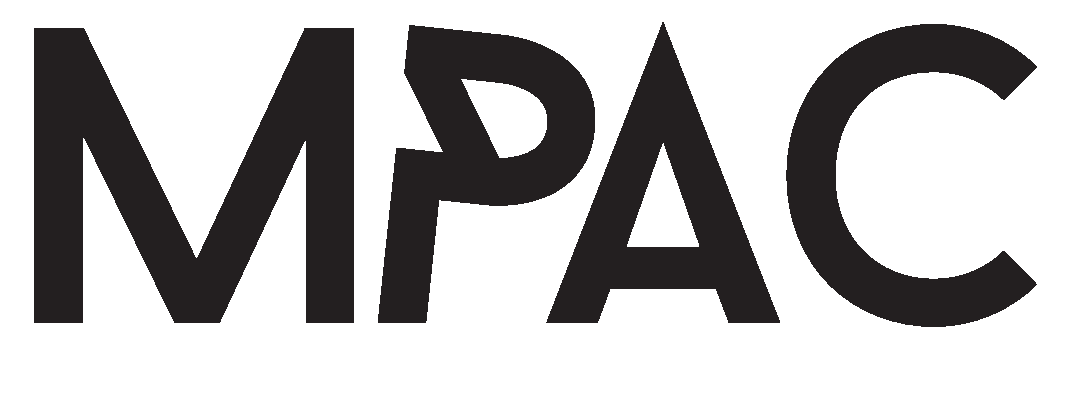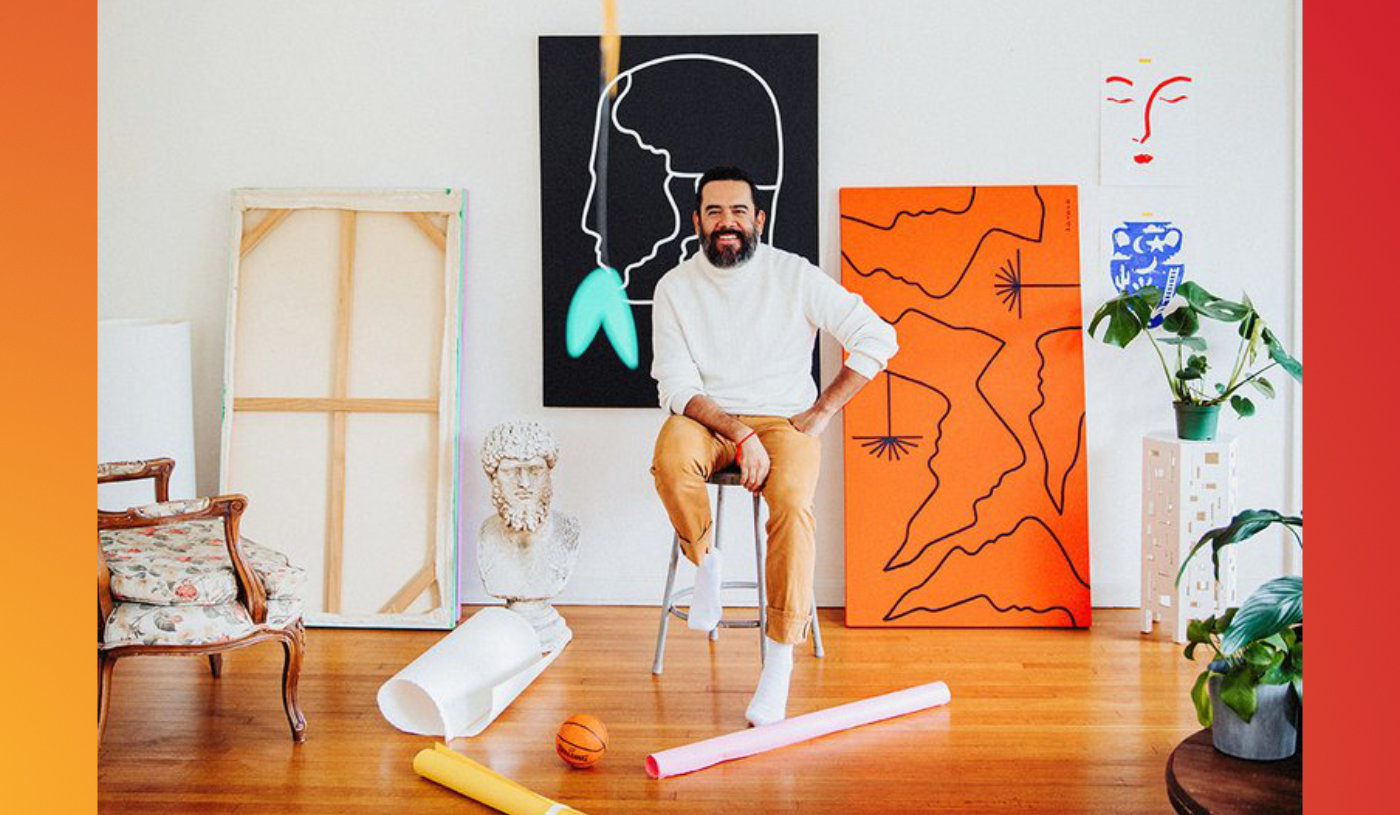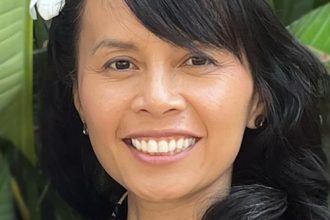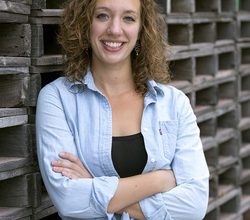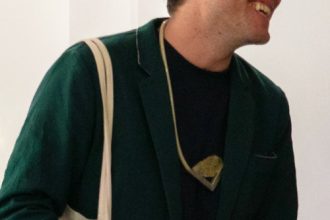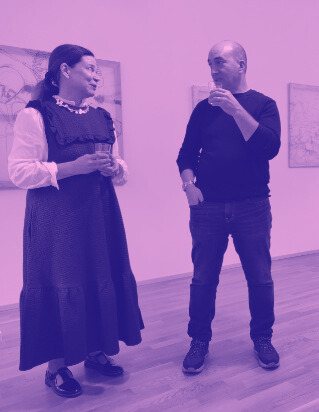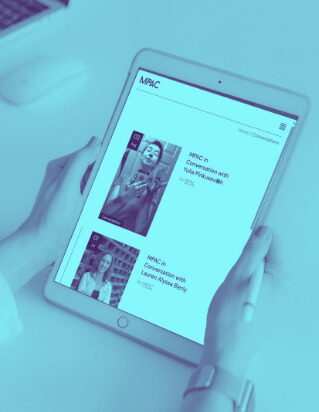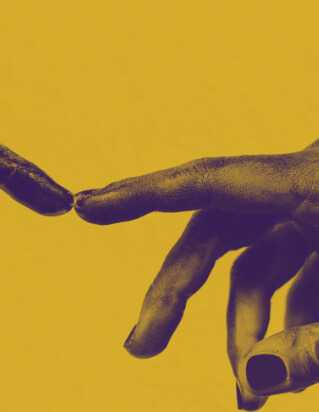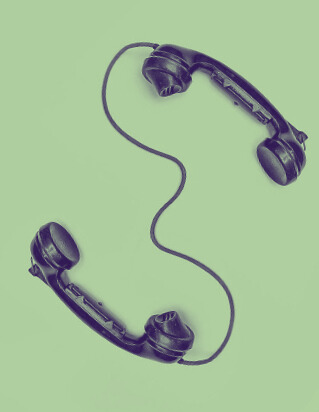MPAC in Conversation with Luis Zavala Tapia
Vuslat D. Katsanis
Luis, it’s a pleasure to finally have this opportunity to speak with you. Would you start by sharing a few words about how you began practicing art? I know that you and Ilknur know each other from the MFA program at CalArts. What’s your journey been like since then?
Luis Zavala Tapia
First of all, thank you for the invitation to have this conversation. Much of the time the art stuff stays in our heads even though, in our community, the audience is such a big part of this crazy endeavor.
I was born in Mexico. I grew up in a house where my parents had a business. My dad was a bike mechanic. My mom sold comic books and candy. So the front of our house served as a storefront. Almost all of my life, it was a bicycle shop as well as a comic book shop. In that creative environment, I grew up wanting to be on the bike all the time and when I wasn’t on the bike, I wanted to be reading comic books. An uncle who was a painter was my childhood influence. He was the artist in the family, and we had the kind of connection that made me realize, at an early age, that I wanted to paint. He wanted to teach me but he had all these rules and boundaries about it. He didn’t want to start until I was 15 or something, I don’t know what the reasoning was.
Also, I never got to see his work because he would never let me. He would let me go into the studio, but he wouldn’t let me see his paintings. And he was always painting, and always had rules. So that mystery got me very curious, turning into a fascination with wanting to see, wanting to look, and wanting to learn. I remember every day after school, I would go to his studio, hoping that today would be the day I get to see his work.
By the time I got to see his work, he had passed away. But I stayed with that feeling that art was secretive, something deeply personal. I also came to understand that just because you make art, doesn’t mean you have to share it.
I think, for example, grad school shares certain similarities in terms of the environment: the critique classes with all the rules, and the criticism aspect of school where you don’t really want to show your art until you really have to. In the critique space, where either you get to be open about your process, or you prepare to have to fight for it, and have somebody critique it… and so I think in many ways, at an early age I knew, art wasn’t free. It had all these secretive boundaries and I operated from those boundaries for a long time. So that’s really how I got involved with this medium that was first about trying to see and learn, and through that process, trying to discover my own self.
So that’s really how I got involved with this medium that was first about trying to see and learn, and through that process, trying to discover my own self.
Ilknur Demirkoparan
Thanks for sharing that. We haven’t seen each other since grad school and it’s nice to have this chance to catch up. We started this conversation by asking the question: what compels one to become an artist? But it’s not really that one becomes an artist; that’s a state of being that one is born into. You train to acquire the discipline to continue doing that which you do naturally, but with the added “knowing.” You don’t become an artist. It’s something that you can’t help but be.
I noticed that, oftentimes, there are disruptions to an artist’s career whereby they are compelled to turn inwards. This has happened to me as well. I’ve continued to do what I do, but I stopped sharing it with the world. Now, I’m at a place where I’m a little bit more vocal again, but I noticed the more outward I turn, the more intimate my work becomes. I see a similar thing happening with your work, especially when you see them in person. There’s something very intimate and very personal… I wanted to ask your thoughts about this disruption and the intimacy we see in your work.
Luis
Yeah, art school was interesting for me because it was a space where I felt a certain pressure as an artist of color. I felt like I had to represent a certain facet of culture, and I’m not sure that I was ready for that. I’m not sure that I feel now that that was a good place for me to be, so I think my work in art school was kind of experimental. I was just trying to find different ways to explore and inform myself. Taking 10 years away from art after grad school was important in terms of discovering the real way that art informs me in my life. What you see now is the result of 10 years of work– it’s 10 years of coming to an understanding that my purpose was higher. My intention before was explorative; my intention today is intentional, and it’s important because that’s what art has provided for me.
Art is a vehicle for understanding myself and for allowing myself to give myself what I need. In the past, I was in a very egocentric space. The way we’re used to interacting with the art world and galleries, and the fact that I worked 10 years in art galleries, not as an artist but as a graphic designer really informed me in terms of realizing my intention as an artist. And it was never to be in a gallery for the purposes of achieving some sort of validation about my ego. It was always about whether my art can reach somebody else. I do of course want my work to be seen publicly, and want people to have access to it. But I want to enable a sort of life that’s meaningful and that’s simple. If I could sell a painting for a lot of money, great! That’s probably the business part of things. But for the last couple of years now, my emphasis has been on an inward journey to reconnect with the way we’re creating. We’re constantly just reaching in there. This work, Mi Cielo, what you guys have in the gallery, is so personal, like, I can’t even. It’s hard for me to even understand sometimes how I can make something like this, but like I said, it’s taken me years to be able to get to this point.
Vuslat
What you’re both describing is that sentiment of why we began with Enduring Time | Material Emergence as our inaugural show. Time, for all of us, for all of humanity, for the past year and a half and counting, has been this extra valuable currency. As much as we are hyper aware of our time during the lockdown of the pandemic, we’re also bound by it in a certain way, almost like we’re trapped. We depend on it, we grow with it, we seek it. I’m curious about this kind of relationship that we have with our time. You both mentioned taking time off from your art practice, which became critically important for you to understand yourself. That distance you gave yourself by taking time off, or the security in secrecy that, Luis, you started speaking about, is intimately bound to your practice.
Ilknur
What I wanted to say about this is not necessarily about time off, but time alone. Without the clutter, if you will. My mind goes back to art school again, you know when we learned about Lee Bontecou, and how despite being so in demand, had suddenly disappeared for 10 years but continued to work in an isolated location somewhere nobody knew about. Or Shirin Neshat, who just graduated, obtained her degree, and then the revolution in Iran happens, and it paralyses her for the next 10 years. Taking time alone to not do any art doesn’t necessarily mean one doesn’t critically evaluate their time.
There is this notion that the artist is always expected to respond to the moment. This expectation makes me think about the whack-a-mole game at Chuck E Cheese’s. All these calls that invite the artist to respond to something urgent, you know, “oh, we’re looking for artists who do blah blah,” except that they’re not really looking for artists, and they’re not really looking for ideas. They’re looking for artists to illustrate a point that they’re trying to make. I often feel as though responding to those calls is like trying to play the game of whack-a-mole, like whichever trending hashtag you hit the hardest would win. Eventually, I’ve come to realize that this refusal to participate in that game is what makes you endure time; it’s what makes you more sincere and what makes your work even more powerful. And it’s not going to be for everybody. Right? Not everybody is going to resonate with it. Some people may even strongly object, even detest it. But it will spark something. What’s your take on time?
Luis
Well, I do see myself as an artist, but I don’t see myself as being an artist all the time. I feel like my time is so much more spent on making sure I’m okay, healthy, and in the right mindset, because if I’m not, it makes it very difficult to be creative. And so I look at time now as the time to play. How much can I play in my day? Can I make time when I’m not ready? The idea of time for me has to do with how we pass every day. For example, this morning I went to the gym and then here I am. Later, I’ll meditate, maybe I won’t make anything. And I’ll be okay with that.
For a long time, I was under the pressure of needing to produce so much daily work, but I’m conscious now how much I want to create things with intention. If you look at this room, my studio, the majority of this work is small. I’m not quite ready to jump out and make work that’s bigger. This, for me right now, is so much more, because I am not looking at myself as an artist, I’m looking at myself as a human being who needs to be nurtured and who needs to love himself. I don’t think I took the time for that before. So now, time has slowed down. And my ego is not running crazy. I just want to get to a space where I can be my best. None of that answers your questions.
Ilknur
Actually, it does. That’s exactly what I was asking. What you just said reflects exactly my criticism of many of those open calls and the institutional handling of “urgency.” You might remember, back at CalArts, sitting in Charles Gaines’ class, where he would sometimes laugh, and ask, “What is it with these institutions and their crises?” He was also often skeptical of art that quickly responded to the politics of the day. He was very critical of that. And he would also question whether that actually promoted any positive change we want to see in this world, especially if your practice is constantly interrupted to respond to whatever needs an urgent response in that moment. Sort of like the whack-a-mole game again. Are you really going to change anything? An artist isn’t a journalist, right? When you’re so speedily responding to the moment, are you really taking time to reflect on that thoughtfully? What are you actually contributing? It’s even reckless behavior. The refusal to participate in this fastness, and instead to slow down, reflect, and think, and then put something out there with care and intention, is the most responsible thing we can do right now.
I love that you say “I don’t think I’m going to do anything today,” because it’s not always the act of producing something with your hands that makes it an art practice. A part of this practice–and it’s called a practice for a reason–is intellectual. Thinking is doing. Our ideas around work and productivity are erroneously measured in material output. We tend to overlook the process of thinking that happens in the studio. Sometimes your output at the end of the day is a thought.
Luis
You’re right. I mean, thank you for saying that. Sometimes I like to take the perspective that the reason why some people are good is because they spend time nurturing their practice, and not necessarily time spent solely on their practice. I think about anybody who is good at their job. They’re good because they have personal traits to fulfill that, and because they have a way of learning and applying what they’ve learned. At some point, it becomes not that challenging to them, almost like they can do their work with their eyes closed.
We think that because something is no longer challenging or because we don’t have to work as hard, that it’s not really as important. But the reality is every practice takes time. And sometimes– especially with this work that you guys have–I really had no idea what I was doing. I went into it thinking “I want to do this, I’m gonna do this, I’m doing it now.” And I did it. There wasn’t that extended rehearsal of “what does it mean,” it wasn’t informed by so much of that. I like the idea that we as human beings can drive, drink coffee, listen to the radio, answer the phone all the while our minds are doing some other entirely unrelated thing. It’s insane, but it’s the reality of how we are. We have adapted to a way of life where things become second nature, and that’s what I like: the second nature part of doing means we’re good at something.
I want to tell you a little bit about this work, and the blue one specifically because it’s the first one I made in the series.
Last year was hard. I was going through some relationship issues, heartbreak, a lot of stuff. I would often paint as I wondered about what life was, and what would happen next, and if I would be able to handle that next thing in life. It was a day like that when I painted these. After finishing all three, I went to my room to watch TV. This is my normal: I paint, then I do something else, then come back to paint some more. So, this is what happened. I was watching TV and suddenly asked myself the question like why did I choose to paint right now? I had to get up to look at what I painted. That’s when I noticed this one figure with these two other figures inside of it. It was blue and there were clouds. I immediately felt this sense of calm thinking about the expansiveness of the sky. To feel the sky inside of me was this need to expand, not to contract, but to float in the clouds in the blue sky. Actually, I don’t know if you ever had this feeling. I just feel so overwhelmingly consumed with a sense of calmness because I created something. I put into paper something that I actually felt first.
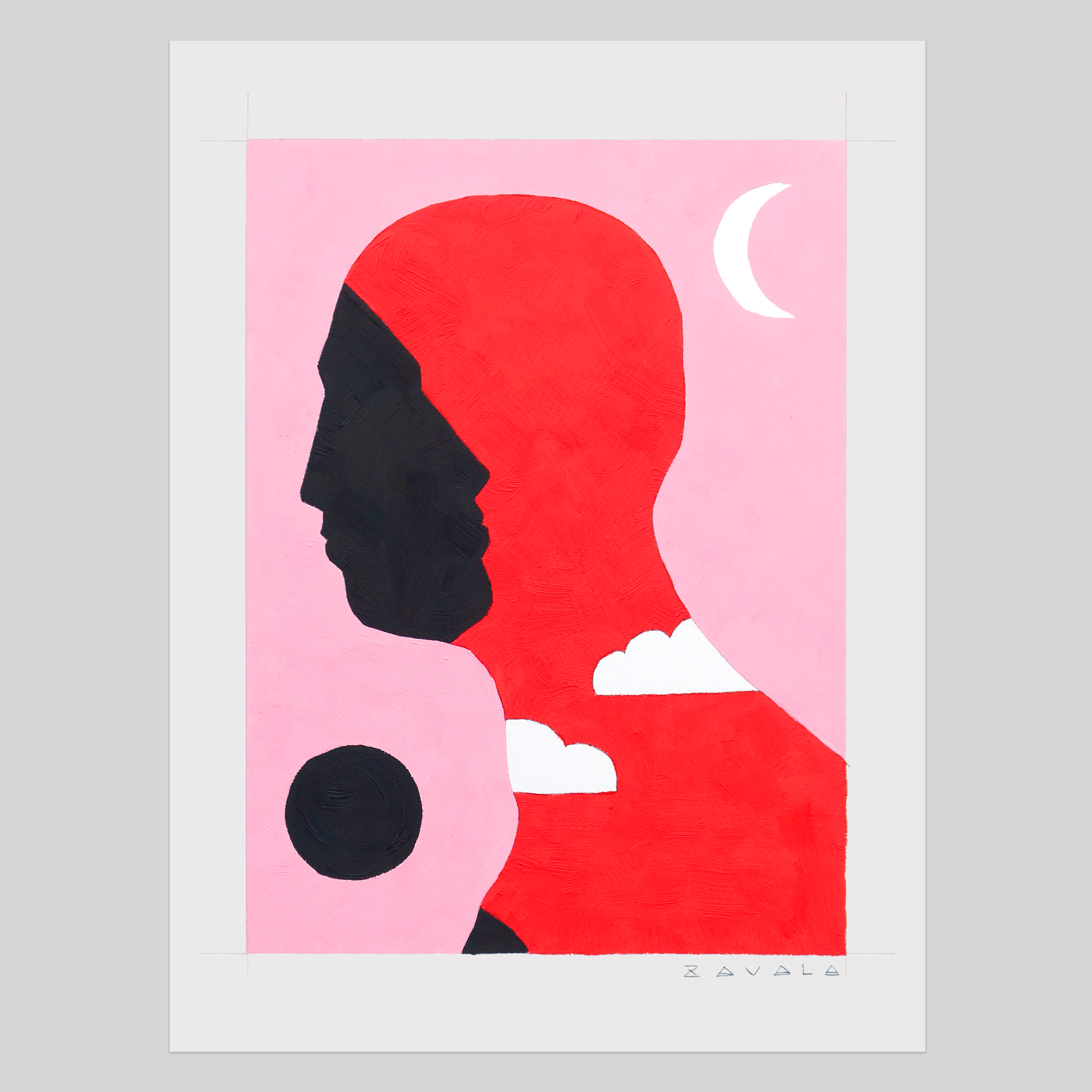
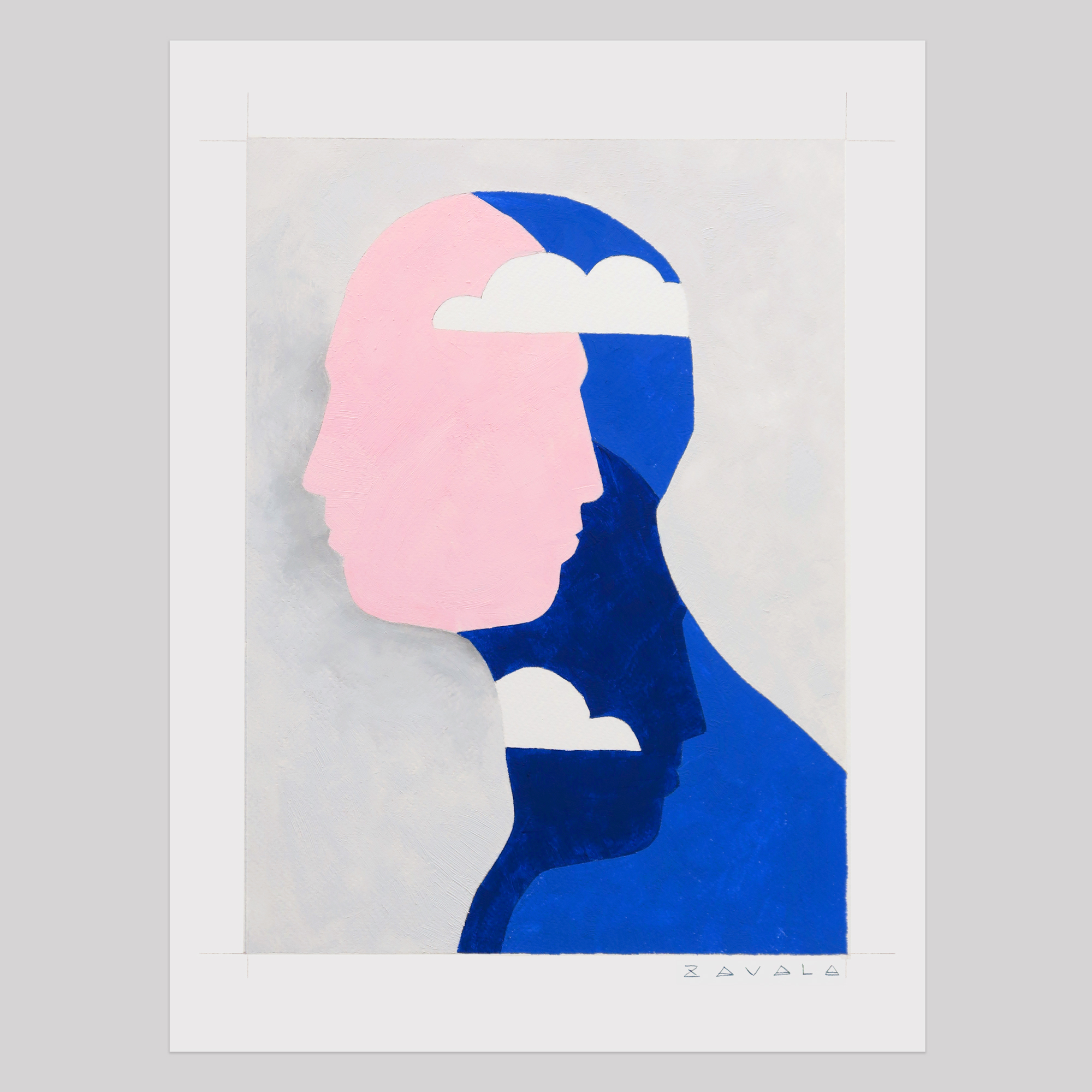
From Luis Zavala Tapia’s 2021 Mi Cielo series. Courtesy of the artist.
Vuslat
Definitely. Can you say a little bit more about the title of the series, Mi Cielo. You talked about the blue one being the first in the series. How was your process making the others?
Luis
The title comes from a Spanish term of endearment. You can say that to your partner. The expression is so powerful that for a long time I hadn’t even considered that they were talking about a sky. There’s a profound personified relationship with nature.
As I mentioned, I was going through a heartbreak. To me it was like finding my sky, like finding my real me. The sky inside of me. I am my sky in the sense that I finally found self-love. And I think it was lacking because I was putting it out in a way where I didn’t know how to love myself, or I didn’t even know how to begin that conversation. I didn’t even know the terminology to begin to have the dialogue with myself. So I think a lot of it is about the love for myself. So that was the first painting. The others came after exploring the time of the day. The pink one is an exploration of the sky in the evening. There’s a change in color, because I’m looking at time through color. I’m looking at the sky in time, as well as the love for oneself, over time.
Coming from another country was always about what you have to do. You have no choice. It was always like, you would get up in the morning, hit the road and go to work. And then, you’re still working when you come home. That was me for the past 10 years. I didn’t know how to stop. But there’s no reason why I can’t feel good every day, even through responsibility, even through things that I have to get done. That’s where it gets personal. I am in a space where I want to really and profoundly feel that love for myself and this work is an attempt at trying to find that within myself again. I’m 43 years old, and I never had this feeling before.
Vuslat
The idea of turning inward to find expansiveness in that inner space at first sounds paradoxical, right? But it’s a journey that one takes, and it’s the most difficult one to take. The scale of these works that you gave us makes the viewer, in a way, perform part of that process of self-discovery, because they need to get closer to your work in order to see it– to really see it. They need to look at it a little bit more directly and for a little bit longer. And in that regard, stepping in closer to see the work expand, I think works beautifully with your choice of scale.
Luis
Scale is important but so is the impact. It’s so different when you look at something so small–by the way, that’s a very typical size that I use, these canvases are the same size, 12 by 16. And I use that size for prints as well. I wanted to make work that you could experience without being overwhelmed. You don’t necessarily need to be that big to feel. What you need to do is allow yourself the ability to see within that small format that there is actually something there, you know, like, if this made such an impact on me, come see why.
Ilknur
The texture is also inviting. The soft powdery surfaces and the delicate ridges around certain contours prompt the viewer to get intimately close to really see these. That’s something I cannot see in the photographs on your website or on Instagram, and you have very good high resolution photos of the work. No matter what, the camera cannot capture the feeling you get while looking at these in person. The way the light moves on the surface, the feel of the texture. It’s almost like there’s an extra treat for people who actually see these in person. I find this to relate to the notions of sincerity and love you mention. That is exactly the sense you get looking at these. And after being locked away for a year and half, when we all had to limit physical contact and maintain social-distancing, it’s almost as if coming out in person and seeing these paintings that require the intimacy of shared physical space is a reward– just really beautiful.
Luis
Thank you for saying that because that’s actually a part of this. I agree with you 100% that I had never used paper, ever, ever. So with this work, I felt there was a sense of discovering and enjoying the tactile beyond just this visual thing.
Lately I’ve been thinking about the words eyesight and insight. The first, by definition, is our ability to see, how we consume images, and the latter our capacity to gain a deep understanding of something or someone, and so on. I’m very much interested in insight right now.
We all have insight: this inner knowledge we have about things without having to see them. And I think that’s where a lot of my work focuses now: on the insight I have about myself as a human in the world. That’s the really beautiful part of seeing as discovery, because what it tells me is I’m constantly looking to go inside to find answers for the outside, as opposed to the other way around. Much of our humanity relies on external things to fulfil uncertainty. Yes we want a family, we want a community, we want things that last. But we also want a car that’s not going to break down, we want material things. So, in the denial and non-denial of our ego, is our wanting to be heard and understood. Accepting all these things about ourselves, that we are not just one thing, requires an insight. Only then do we understand that you’re constantly changing, that everything is changing.
Vuslat
Enduring Time | Material Emergence is our first exhibition in the postcollapse art project, and it’s an honor to do it with you and with Lauren. So much of what you’ve described about your personal journey, going through anxiety and depression, and questioning your sense of self are things that I and I’m sure many other people can relate to as well. And in a way, postcollapse is about trying to situate a way of rethinking our present moment through, first of all our very presence, and secondly through the presence of people that have been left out of that narrative. On the other hand, this unique vantage that we describe as a migrant vantage–as a point of view of someone caught in the liminal space of here and elsewhere– resonates with so much of what we can call the contemporary world experience.
Luis
What resonated for me to be honest with you is that it speaks volumes about where I am in my life right now. I want to be open. Honestly, I think in the past I would have asked for more information to know what I’m getting myself into and whether I feel comfortable about it. I’m in a space now where I accept things happening for a reason. So I think so much of the way I function now is about being open. That openness is part of the expansion, as part of the work in the paintings that I’m making. Your invitation was an opportunity to not question because I could feel a sense of connection at a deeper level. That’s why I trust you guys.
Ilknur
I’d like to go back to the idea of representation, especially at this time in which we have to rethink our contemporary and how we contextualize our place within the art world. You mentioned your frustration with how you were expected to represent a certain image of your culture, as if you were a spokesperson or an ambassador of your culture. I’m laughing, sorry, as I say this, because it really makes you think about the absurd power dynamics of who really represents whom in the end, and what they want to show.
Similarly, I know that as an artist, I’ve also felt frustrated many times and I actually did engage with identity in my work. I realized, coming here to the United States as a 10 year old child in 1989, where I flew over a portion of the world that was the Eastern Bloc and walled off, and then within months, even as a young kid, I remember, the wall coming down, and it was an entirely different world. So not only did I realize I was not going to go back to the same reality, I was coming into a different country.
And, I became aware of how my identity was perceived. Growing up, when you’re a little Turkish kid in Türkiye you’re not made to think about your identity. But when you become a minority, especially if you’re part of a villainized group, you grow into awareness. I remember as a 10 year old somebody asked me about Midnight Express, if the Turkish prisons were really that horrible, and I was like, why would I know that as a 10 year old? It was just ridiculous. Why would you ask a child that? So I can understand, as artists, we’re asked very frequently to represent ourselves, but I’ve started being very critical about that ask. Are we putting on a show? And what does that say about the institution that is trying to represent, trying to be diversify?
You’re also a child of an immigrant. You immigrated here when you were a kid and you found yourself in unfamiliar land where you had to gain familiarity. Then you have to also see yourself being seen in order to get accustomed to the new space. What I find so clever about how your identity reflects in your work despite that refusal to play the ambassador role, is how you use the colors. Your palette is composed of the memories of your childhood in Mexico. It’s the life you live now in California. It’s the way the sun illuminates things; the vibrancy of the red. I see how you talk about yourself and your memories without having to answer for your identity or to justify its place within contemporary art, which we are often asked to do as minority artists.
Luis
I was 14 when we came here. I remember everything was new. There was no one like me here. We certainly didn’t have anyone to relate to back then, we were completely a minority. But then you fast forward to now, and California might as well be Mexico. From that perspective, it took a process of learning where you came from and adapting to where you are at 14. You’ve developed so much awareness about your identity. But then you’re also having to kind of reject it in some ways because, if you don’t, then how do you adapt? So it’s been a struggle to maintain a type of connection. I’m able to distinctly say I’m connected to Mexico and I always will. And I think of myself as Mexican. l consider myself an American.
That’s my reality and it’s so hard for me to really comment on that aspect in my art because I don’t think that I’m very good at it. But, how it’s informed my art 100% comes through memory. When it comes to colors or our language, those are easy to consume because you don’t have to think about them. I was just using blue, which I love to use. With blue, you’ll start thinking about Greece or about French paintings, or French ultramarine. There’s so much history in color.
But the identity thing is interesting. I recently met somebody who I didn’t know personally but who knew my work, at a bookshop. The first question they asked is, “I love your work, but I’m curious, you’re from Mexico. Why is your work about Greek mythology?’
Yes, our ancestors were overcome by disease, our lands were conquered, but I’m interested in healing. I’m not interested in promoting this idea that I am mad; that doesn’t help our people.
I see my work as connected to an entangled human history. I love the idea that I can speak about forms that have influenced the world, history, and politics. I love that life is constantly showing you where things come from and where they collide.
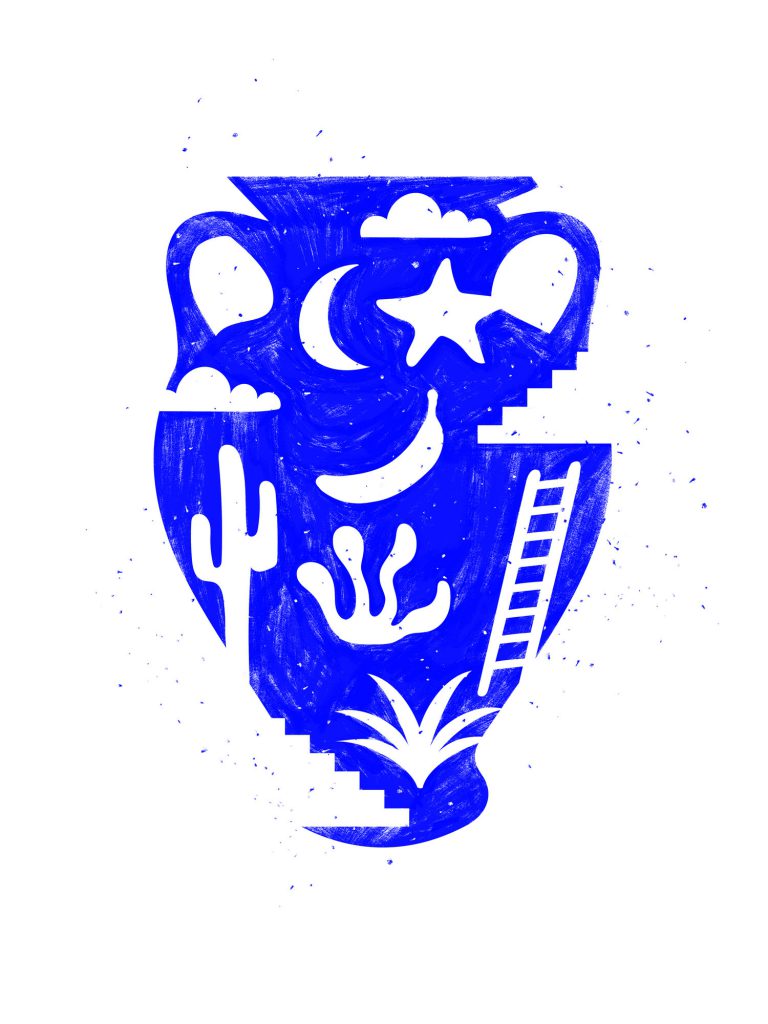
I see my work as connected to an entangled human history. I love the idea that I can speak about forms that have influenced the world, history, and politics.
And that brings me back to the question, Where do I come from? I come from a third world country. Things are not that great there. People come here and they realize they can make a different kind of life. Nothing wrong with that. I think it’s just being an artist and also being a human wrestling with the world is so interesting, it’s so beautiful, so I try to focus on the aspects of what we can do to heal. There’s lots of artists who represent anger for other people. I want to focus more on the aspect of how I live my life with presence and intention.
Ilknur
You know it’s really curious. You were asked that question about why you would draw inspiration from ancient Greek mythology, but a German artist or a French artist would never be asked this question if it were the other way around. And we see a lot of references throughout the ages where Western Europe does hone into the Mediterranean, but their inspiration could never be questioned whereas yours would be, even though the mythologies speak to a very existentially human element.
Luis
As an artist, I would encourage young artists not to go to art school. I feel like my perspective and experience have taught me that you just need to trust more in yourself. Art school can be great for some people. For me I needed to go there to understand that that’s not what I wanted. I would encourage a class on play over a class on criticism. So I would hope that when people look at my work, they don’t say, “oh, this particular part is such” or “such or like this was really simple.” It’s my own path, you know, and I went through a lot to get to this point.
So, if somebody asked me for advice, I would say don’t go to art school. Do what you want to do fully and take the steps you need to get you there. All these procedures and ways of thinking are so old school. Who knows what it’s going to be like in the future and how art will be made and what the process or the modalities of how to be a successful artist will be? I don’t know. I do know, however, that a successful human is one who accesses space for everything they feel and everything that is difficult, as well as everything that is good. So, hopefully my work can have a sense of that personal approval, which is an attempt to heal myself and give myself the things that I need.
Vuslat
The more I have this chance to hear from you about your practice the more I understand that you really value self-reflection. It’s humbling. I’m a professor here in Washington, and a lot of my students–usually the ones who have that inner eye, full of ambition–ask me about graduate school and I hesitate what to say. Oftentimes, the best students are also the most sensitive. Our institutions, however, have turned into vicious places, completely desensitized, and I hesitate to encourage that system.
Luis
I had an amazing undergraduate program. You know, I went to the Art Institute of Chicago, and I learned so much there, accessing the kind of art that I wanted to make. And the reason why I went on to CalArts was because I wanted to be a professor. That was my goal. I wanted to get to the point where I could talk to students and tell them, hey, here’s how you can do this right. I don’t know if you remember but in CalArts, there was a class called, “Getting Your Shit Together.” It was all about, you know, how to get your shit together so that you can be a successful artist. I would have loved to teach a class about how to get your shit together in a different way, like, keeping your mind right, figuring out how to get financial stability. So you can be free to explore and play, and create art versus what these art schools have turned into.
Ilknur
IIt’s interesting how we started the conversation talking about enduring time and our practices as artists, and how an artist isn’t something you become through training; it is a state of being that you’re born into. And we talked for an hour and a half now, and somehow landed back exactly here. I think the reason why we return to the question of who we are as human beings is because we are in an existential crisis right now. I mean, going back to Charles Gaines’ criticism: What is it with institutions and their crisis? I think what’s really happening right now is that we’re at that “oh shit” moment where we really have to rethink everything. We need to be sincere and reconnect with ourselves, rethink art school, rethink our institutions. That’s the thing about the institution failing. As artists, we refuse to participate in this, but we continue to practice. It is our resilience. I think that’s when it becomes really powerful to have artist-run spaces. That’s where we can make a change and you see more and more references to Black Mountain College, which was like a non-school, but it was a school, which emerged at a critical point in time. So, I really believe that we are right now at that time, when the time is right to really think what the hell we’re doing in this world, and to say that we cannot honestly continue in this way.
Vuslat
And relatedly, we need to rethink and re-educate how we think about each other, how we relate to one another as humans, how we depend on nature. Then we rethink the entire system including graduate school, academia, and the museum as institutions that have been stripped of care as a core value. Nobody talks about the institution as a space that cares, right? What I’m hearing is that you want to bring that back in, you want to bring back the humanity in our collective effort and I really appreciate that.
Luis
Thank you. I appreciate you both for including me in this exhibition and I love what you wrote about it. I feel like you’ve seen me, and that’s what I hope to do for other people too. We all want that: to be seen and to appreciate each other for who we are.
Ilknur
That’s beautiful. You are doing that, I look at what you do, and I see you in them. I get a sense of you as a person through your art, and it’s powerful to have that kind of connection with a thing. It’s like magic. Thank you.
Luis
No, thank you for saying that, because I want other people to allow themselves the idea of being in all the magic. And there’s so much magic in the world, beyond the kind of magic and sorcery that we create, it’s like there’s a lot of beauty and there’s a lot of difficulty, too. As hard as it is for me because it is our struggle, and it’s a constant, I was just reading the book about Matisse. I didn’t know just how much he was suffering in his time. He had anxiety, and his wife was all he had. That sounds very familiar. Being an artist is also being vulnerable. We feel deeply and therefore, everything feels much stronger.
Vuslat
Thank you again. What an inspiration to speak with you!
About:
Luis Zavala Tapia is a Mexican-born artist based in Long Beach. He holds an MFA from California Institute of the Arts (2007) and a BFA in painting from The School of the Art Institute of Chicago (2004).
